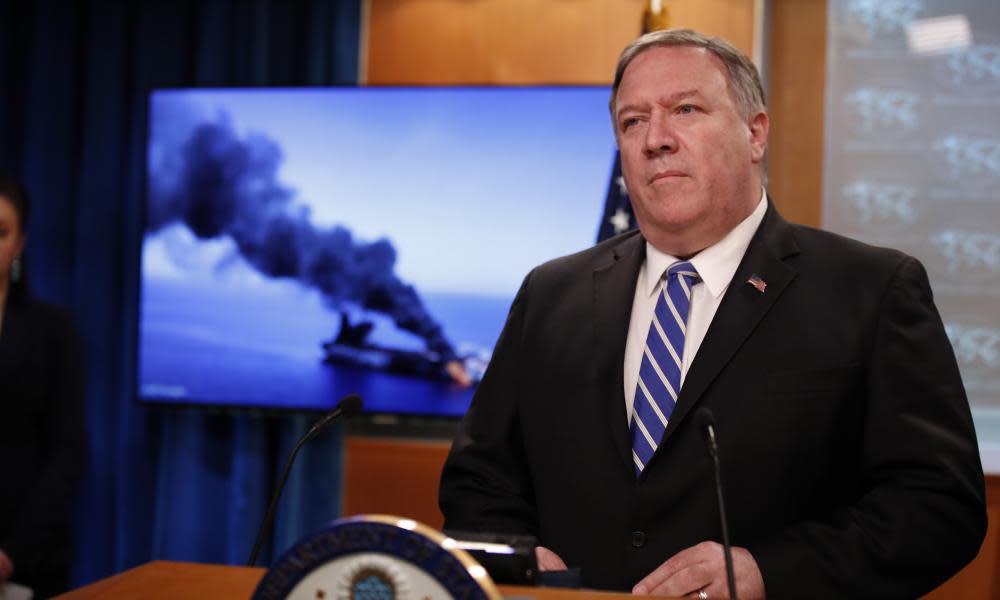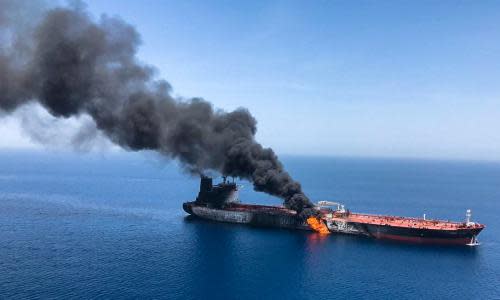US releases video it says shows Iranian military removing mine from tanker

The US military has released video footage it says shows an Iranian military patrol boat approach one of two tankers attacked in the Gulf of Oman on Thursday, to support the Trump administration’s claims that Iran was responsible.
The blurry black and white footage, taken from the air, shows a small military boat alongside a tanker and someone stand up on the prow of the boat to remove an object from the tanker’s hull. The small boat then pulls away from the tanker. US officials were quoted as saying the boat was an Iranian Revolutionary Guard patrol boat approaching the tanker after it was attacked, and the object removed was an unexploded limpet mine.
It was unclear whether it was being alleged the Iranian sailors were detaching the mine in order to remove evidence. The incident added to security fears over oil tankers traveling out of the Persian Gulf, and appeared to have snuffed out a Japanese-led mediation effort. One of the tankers attacked on Thursday was Japanese owned.
Earlier the US secretary of state, Mike Pompeo, said the US believed blasts on the two tankers were caused by the Iranian military “based on intelligence, the weapons used, the level of expertise needed to execute the operation”. He also claimed that the attacks, had such a high degree of sophistication they could not be have been carried out by a proxy.
Related: Oil tanker attacks will inflame conflict between the US, its allies and Iran
Pompeo offered no evidence for his claims and took no questions after making his allegations. He said that Iran had been responsible for a previous wave of attacks on tankers last month, but the official investigation into those attacks did not determine who had been responsible. He also claimed a 31 May car bomb in Afghanistan which killed Afghan civilians and wounded four US soldiers, had been carried out by Iran. The attack had been claimed by the Taliban.
Pompeo declared Iran’s actions “present a clear threat to international peace and security”. He added: “Iran is lashing out because the regime wants our successful maximum pressure campaign lifted. No economic sanctions entitle the Islamic Republic to attack innocent civilians, disrupt global oil markets and engage in nuclear blackmail.”
Tehran denied all responsibility and its foreign minister suggested others could be trying to provoke a conflict between Iran and the US.
The incident took place on a day Iran’s supreme leader, Ali Khamenei, bluntly rejected the proposal of a resumption of US-Iranian talks, suggested by Japan’s prime minister, Shinzo Abe, on a visit to Tehran.
Abe is widely thought to have had the blessing of Donald Trump in offering to open a channel of communications between the US and Iranian leaders.
But after Khamenei’s rejection and the tanker attacks, Trump followed suit, posting a tweet saying: “While I very much appreciate PM Abe going to Iran to meet with Ayatollah Ali Khamenei, I personally feel that it is too soon to even think about making a deal. They are not ready, and neither are we!”
The blasts on the tankers, the Japanese-owned Kokuka Courageous and the Norwegian-owned Front Altair, pushed oil prices up by 4% and could further raise insurance premiums for vessels operating in the Gulf.

The 23 crew members on Front Altair were rescued by a nearby vessel then transferred to an Iranian navy boat and disembarked at a local Iranian port. The 21-strong crew on the Kokuka Courageous were rescued by a Dutch tugboat and then taken aboard by the destroyer, USS Bainbridge. One of the crew had suffered burns on his hands and was treated immediately by a US Navy medical team.
Confirming the involvement of its ships, US Central Command issued a statement warning it would not tolerate any attempt to interfere in their operations but insisted it was not interested in conflict.
“We will defend our interests, but a war with Iran is not in our strategic interest, nor in the best interest of the international community,” the statement said.
It added that the destroyer USS Mason was en route to the scene of the attacks to support the Bainbridge.
Iran is locked in a volatile standoff with America after Washington imposed crippling economic sanctions on Tehran in a bid to force the renegotiation of the 2015 Iran nuclear deal, and curb interventions in Syria, Yemen and Lebanon.
Saudi Arabia supported Pompeo’s claims. Its foreign minister, Adel al-Jubeir said on Thursday: “We have no reason to disagree with the secretary of state. We agree with him.”
The UK foreign secretary, Jeremy Hunt called the tanker attacks deeply worrying but said Britain would be making its own assessment of responsibility.
The Iranian foreign minister, Javad Zarif, denied any involvement, saying the country was “beyond suspicion”.
Related: A visual guide to the Gulf tanker attacks
Despite talking to Trump before flying to Tehran, Abe insisted he was not bringing specific detailed messages on behalf of the US president. But Ayatollah Khamenei dismissed the notion of talks saying in a series of tweets “I do not consider Trump as a person worth exchanging any message with and I have no answer for him, nor will I respond to him in the future”.
He added Iran had no plan to build nuclear weapons, but if it wished to do so, the US would be unable to stop it. “We believe that our problems will not be solved by negotiating with the US, and no free nation would ever accept negotiations under pressure.”
Pompeo said the attacks on the tankers were intended as insult to the Japanese leader.
“Iran’s supreme leader rejected Abe’s diplomacy today by saying he has no response to president Trump and will not answer. The supreme leader’s government that insulted Japan by attacking a Japanese-owned oil tanker just outside of Iranian waters, threatening the lives of the entire crew creating a maritime emergency,” he said.
The US put its allegations before a closed session of the UN security council on Thursday. Iran responded by accusing the US of stoking tensions and mounting a campaign of crippling sanctions.
“The US economic war and terrorism against the Iranian people as well as its massive military presence in the region have been and continue to be the main sources of insecurity and instability in the wider Persian Gulf region and the most significant threat to its peace and security,” the Iranian mission to the UN said in a statement.
The United Nations secretary-general, Antonio Guterres, strongly condemned the attacks, warning that the world cannot afford “a major confrontation in the Gulf region”.
Russia pleaded with the US and the Gulf States arrayed against Iran not to leap to conclusions.
Britain said it was available to help with any investigations into the source of the attack. The investigation is likely to be handled initially by the ships’ owners with a report given to the UN security council.
The Norwegian Maritime Authority said three explosions were reported on the Norwegian-owned tanker Front Altair after it was “attacked”, leading to a fire and fears at one point the ship would sink.
The ship was carrying 75,000 tonnes of naphtha, a petrochemical feedstock, which trade sources estimate to be worth more than $30m. The ship burned for hours, a fire that charred half of one of the vessel’s sides sending up a column of thick, black smoke.
Investigations into the previous attack on the four tankers struck on 12 May led the US to claim Iran was “almost certainly” behind that attack. Two Saudi, one UAE and one Norwegian oil tanker were damaged. A separate investigation by Norway, the UAE and Saudi, led to claim that a state-like actor had to have been involved due to the sophistication of the operation.
Ilan Goldenberg, a former senior state department official said: “I’ve been saying for the past month that threat of war with Iran is overhyped. Not after today. This seems like a serious escalation.”
The concern is that the crisis will spiral out of control with further attacks leading to an effective closure of the Strait of Hormuz, a narrow two-mile-wide shipping lane between Oman and Iran through which a fifth of the world’s oil ships navigate. Some 18.5m barrels of oil are transported through it every day from major Opec energy producers Saudi Arabia, the United Arab Emirates and Kuwait.

